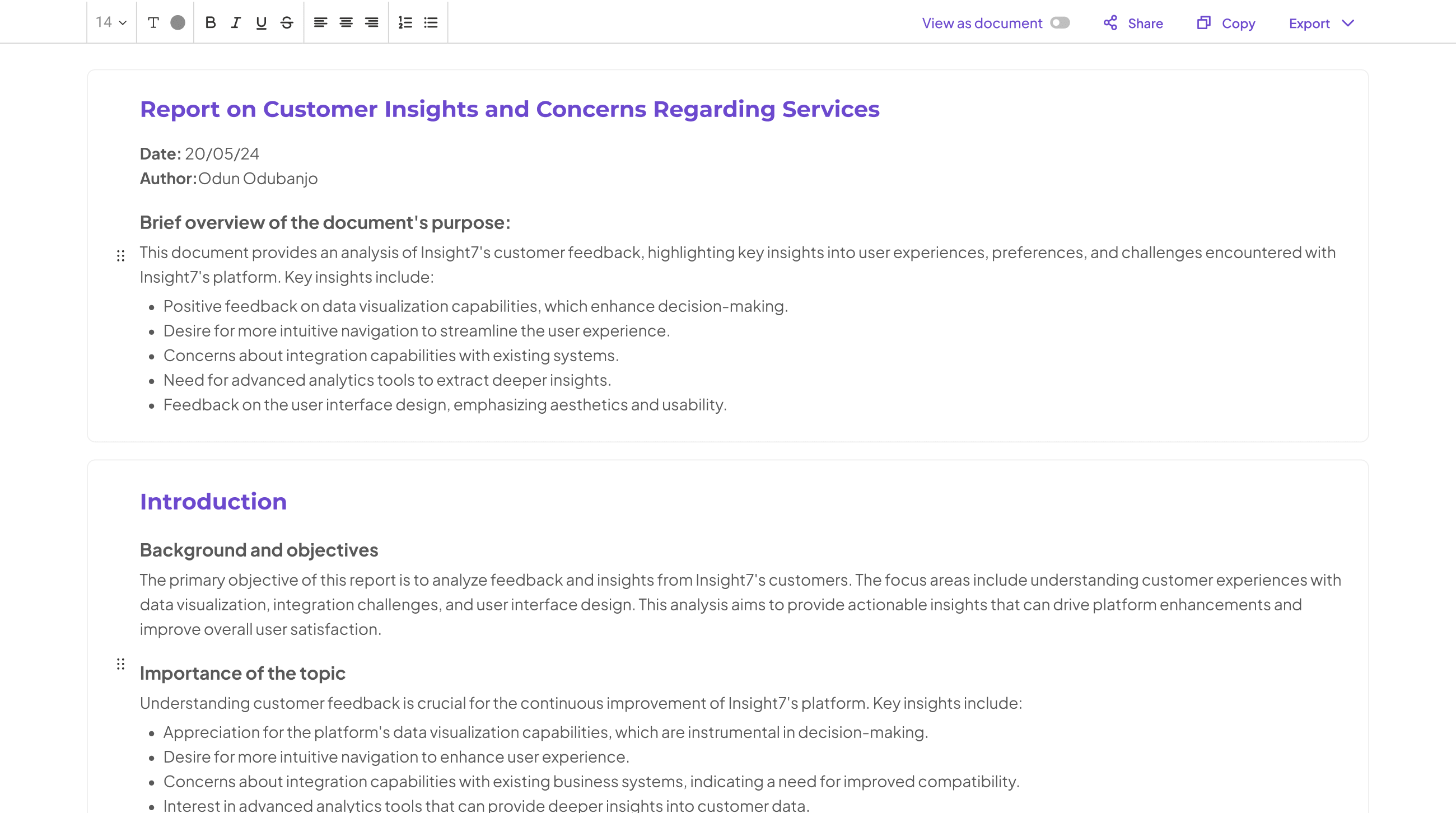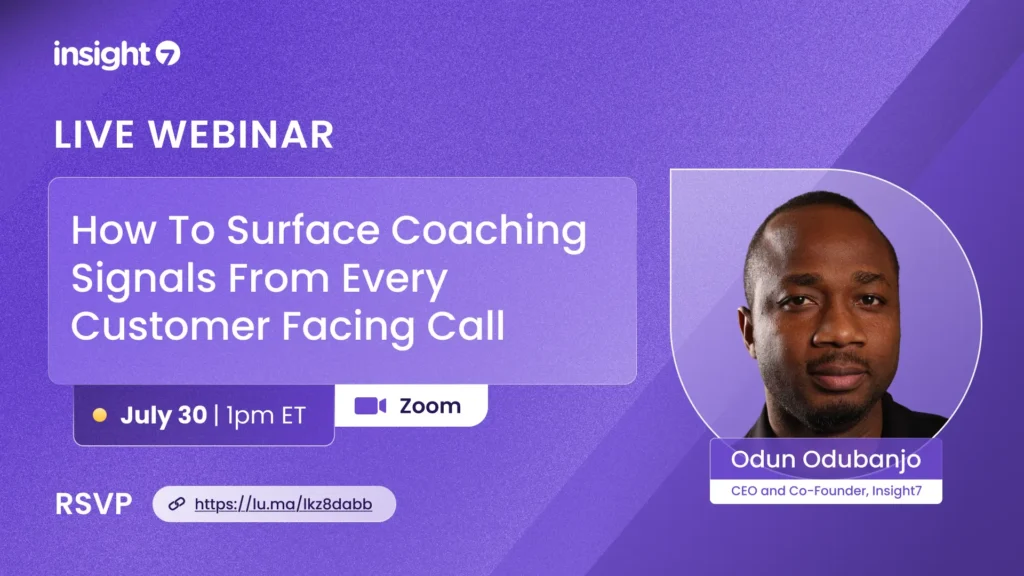How to visualize reports from prospect calls
-
Hello Insight
- 10 min read
In today’s data-driven world, transforming raw insights from prospect calls into clear visual reports is essential for strategic decision-making. Call Report Visualization not only simplifies complex data but also highlights trends, making it easier for teams to understand customer needs and refine their approaches. Effective visualizations enable stakeholders to quickly grasp critical information, fostering deeper engagement and informed discussions.
To harness the full potential of Call Report Visualization, organizations must prioritize clarity and relevance in their reports. By selecting the right visualization tools and designing intuitive charts, teams can transform prospect call reports into actionable insights. This approach empowers decision-makers to identify patterns and uncover opportunities, ultimately driving more effective business strategies.
Transcribe & extract insights from interviews. At Scale.

Understanding Call Report Visualization
Understanding Call Report Visualization is essential for transforming raw data from prospect calls into actionable insights. By utilizing effective visualization techniques, you can uncover trends and patterns that may otherwise remain hidden. Through this process, you not only streamline data interpretation but also facilitate communication among team members, making it easier to align strategies for future engagements.
To achieve meaningful Call Report Visualization, consider the following components: First, identify the key metrics that reflect your goals, such as call durations or customer feedback ratings. Next, choose appropriate visualization tools—consider using interactive dashboards that allow team members to explore data dynamically. Lastly, prioritize clarity in design. Ensure that charts, graphs, and tables are easy to read, allowing stakeholders to grasp insights quickly. By focusing on these elements, you can enhance your team's understanding of prospect interactions and drive more informed decision-making.
Importance of Visualizing Prospect Call Reports
Visualizing prospect call reports is essential for extracting valuable insights from customer interactions. Call report visualization aids in identifying patterns, trends, and key feedback that can inform decision-making processes. By transforming raw data into clear and engaging visuals, teams can swiftly grasp the sentiments expressed during calls—both positive and negative—and adapt their strategies accordingly.
Understanding the importance of these visuals lies in their ability to simplify complex information. First, they facilitate better communication among team members, enabling everyone to easily access the same data interpretations. Second, they support strategic planning by providing quick references to customer preferences and behaviors. When stakeholders can see the data represented visually, they are more inclined to draw actionable conclusions. This reinforces why investing time in effective call report visualization can transform the way organizations understand and respond to their market.
Key Elements in Call Report Visualization
Effective Call Report Visualization focuses on transforming raw data into comprehensible formats. To accomplish this, consider several critical elements. First, identifying key metrics to highlight is essential. Metrics provide insights that matter most and drive decision-making. Next, integrating visual tools, such as graphs or infographics, enhances the report’s accessibility. This facilitates easier understanding of complex information for all stakeholders involved.
Additionally, interactive elements can significantly improve engagement. Dashboards, for instance, allow users to explore data at their convenience. Color schemes and fonts should also be chosen carefully; they should be appealing yet functional, supporting clarity over aesthetics. Finally, ensuring that the visualization aligns with your audience's needs is paramount. Tailoring the call report visualization will help align insights with the specific interests of your stakeholders, making the process impactful and effective.
Generate Detailed Reports from Your Qualitative Data in Minutes.
Implementing Visualization in Prospect Call Reports
Implementing effective visualization in prospect call reports is crucial for translating data into actionable insights. Call report visualization begins with the process of collecting relevant data from each call, ensuring that critical metrics are captured consistently. This foundational step allows for richer analysis, enabling teams to identify patterns and trends that may not be immediately apparent in raw data.
Once the data is collected, choosing the right visualization tools is essential. This choice can profoundly affect how information is interpreted and communicated. Effective tools such as Tableau or Microsoft Power BI can create more engaging and informative representations, like charts and graphs. After selecting the tools, the focus shifts to designing clear visuals that prioritize simplicity and clarity. This ensures that stakeholders can easily understand the insights derived from prospect calls. By implementing these steps, organizations can derive greater value from their prospect call reports through enhanced visualization.
Step-by-Step Guide to Effective Visualization
Effective visualization of prospect call reports begins with a structured approach. The first step involves collecting relevant data from the calls. Gather information such as customer sentiments, trends in feedback, and unique points raised by prospects. This foundational data is crucial for developing a comprehensive visual representation.
Next, it's essential to choose the right visualization tools. Numerous options exist, including popular software like Tableau and Microsoft Power BI. Selecting the appropriate tool can enhance the clarity and impact of your visuals. Finally, design clear charts and graphs to represent your findings effectively. Focus on readability, ensuring that crucial insights stand out. By following these steps, you will create a persuasive visualization of your call reports that highlights actionable insights and supports informed decision-making. This holistic approach to Call Report Visualization will ultimately improve your understanding and strategy based on direct customer feedback.
- Step 1: Collecting Relevant Data
Collecting relevant data is the foundation of effective call report visualization. Start by gathering information from your prospect calls, ensuring you capture key details such as customer feedback, sentiments, and patterns in responses. This information acts as the raw material that enables you to derive meaningful insights. It's crucial to be thorough in your data collection process, as overlooking significant feedback can lead to a skewed representation of customer insights.
Moreover, consider organizing your data by categorizing feedback into positive, negative, and neutral sentiments. This structured approach allows you to visualize trends effectively across different datasets. For instance, the inquiries regarding specific products or services can reveal common concerns or praises. With a well-collected dataset, you provide yourself with the ability to create impactful visualizations that drive informed decision-making, enhancing your overall call report strategy.
- Step 2: Choosing the Right Visualization Tools
Selecting the appropriate visualization tools is crucial for effective call report visualization. The right tools offer intuitive interfaces that allow you to turn raw data into meaningful insights. Start by assessing your specific needs. Consider user-friendly options that can easily integrate with your existing data sources. Tools like Google Data Studio and Tableau are particularly useful for creating dynamic visual representations. They cater to various expertise levels, from novices to seasoned analysts.
Once you've narrowed down potential tools, think about the type of visuals you'll need. Charts and graphs can effectively showcase trends, while heat maps illustrate customer sentiment. Don't forget to evaluate the tools based on their scalability; you want options that can grow with your reporting needs. By aligning your visualization tool choice with your data strategy, you enhance the communicative power of your call report insights.
- Step 3: Designing Clear Charts and Graphs
Creating effective charts and graphs is essential for impactful call report visualization. Begin by identifying key insights from your prospect calls, such as customer feedback and emerging trends. Choose the right type of chart—line graphs for trends over time, bar charts for comparisons, and pie charts for proportions—ensuring that each chart conveys a clear, focused message.
Next, maintain simplicity. Avoid cluttering your visuals with excessive data points or overly complex designs. Aim for consistency in colors and fonts to enhance readability. Label axes and provide legends when necessary for complete context. This thoughtful approach to visual data representation not only enhances understanding but also engages your audience, allowing them to swiftly grasp the main points from your reports. By investing time in designing clear charts and graphs, you significantly improve how stakeholders interpret data from prospect calls.
Top Tools for Call Report Visualization
To effectively harness the power of Call Report Visualization, selecting the right tools is crucial. Various platforms can transform raw call data into engaging visuals that allow teams to grasp insights quickly. Insight7 stands out for its user-friendly interface that supports comprehensive analytics tailored for prospect calls. Tableau offers robust capabilities for creating diverse visual representations, accommodating complex datasets seamlessly.
Microsoft Power BI also provides solid analytic features, ideal for businesses seeking to integrate their reporting tools with other Microsoft products. Google Data Studio excels in providing real-time data updates, enabling teams to create shareable and interactive reports. Lastly, Zoho Analytics rounds out the options, delivering a versatile platform for custom visualizations and deep insights. Each tool plays a vital role in enhancing how reports from prospect calls are seen and understood. Therefore, choosing the right tool ultimately aids in making data-driven decisions that can lead to better business outcomes.
- Insight7
To effectively visualize reports from prospect calls, one must focus on making the insights clearly understandable. Call report visualization is a powerful tool that turns complex data into simpler visual formats, enabling faster decision-making processes. Engaging visuals such as charts, graphs, and infographics can illustrate trends, customer feedback, and call outcomes, allowing teams to grasp the nuances of prospect interactions easily.
To achieve successful call report visualization, consider these approaches: first, ensure thorough data collection, gathering all relevant insights from the calls. Next, select the most appropriate tools that cater to your visualization needs. This could range from Tableau to Google Data Studio. Finally, design your charts and graphs with clarity in mind, emphasizing key metrics that reflect your objectives. By following these steps, teams can transform their call reports into actionable insights that drive strategic decisions and enhance overall customer engagement.
- Tableau
In the realm of call report visualization, Tableau stands out as a powerful tool for transforming raw data into engaging visual insights. This software excels at taking complex datasets and distilling them into easily digestible formats, allowing users to make informed decisions based on prospect call data. By utilizing Tableau, you can create diverse visualizations, such as charts and graphs, that highlight significant trends and feedback from your calls.
To effectively utilize Tableau for call report visualization, start with organizing the data collected from prospect calls. Next, use Tableau's intuitive interface to select appropriate visualization formats. You can then generate insightful dashboards that not only display essential metrics but also allow for dynamic filters and comparisons. By employing Tableau, stakeholders can gain a clearer understanding of customer sentiments, identify patterns, and ultimately enhance their strategic actions based on the meaningful insights derived from call reports.
- Microsoft Power BI
Microsoft Power BI stands out as a powerful tool for Call Report Visualization. This software allows businesses to transform raw data from prospect calls into compelling visual narratives that inform decision-making. By utilizing a seamless interface, users can easily create interactive reports that highlight positive and negative feedback, trends, and sentiments derived from calls.
To effectively leverage Power BI for visualizing call reports, users can follow a few essential steps. First, they should collect relevant data, ensuring comprehensive coverage of insights derived from prospect interactions. Next, selecting suitable visualization elements, such as bar charts or pie charts, can enhance the understanding of the data. Finally, designing clear and concise reports will allow stakeholders to grasp insights quickly, aiding in strategy development and future enhancements. By fully harnessing Power BI's capabilities, organizations can gain valuable perspectives that drive better engagement and innovation.
- Google Data Studio
When considering Google Data Studio for Call Report Visualization, it serves as a powerful tool for transforming raw data into interactive reports. Its user-friendly interface allows users to create visually appealing dashboards that provide essential insights from prospect calls. The ability to connect multiple data sources means that you can consolidate key information to get a holistic view of your calls and outcomes.
Using Google Data Studio enables you to customize your reports based on your specific needs. You can create visualizations such as charts, graphs, and tables that highlight trends and feedback from calls. This capability allows teams to quickly identify positive and negative feedback, guiding product development and customer engagement strategies effectively. As you evaluate your results, Google Data Studio’s collaboration features further enhance team discussions around the insights, leading to informed decision-making based on comprehensive data visualizations.
- Zoho Analytics
When it comes to Call Report Visualization, understanding how to effectively use tools like Zoho Analytics can enhance your insights significantly. This platform allows for flexible data manipulation, enabling users to extract meaningful patterns from prospect calls. By creating visual representations of call data, users can identify trends, positive feedback, and areas that require improvement.
Utilizing Zoho Analytics involves several steps. First, you’ll need to collect relevant data from your recorded calls. Following this, you can select suitable visual formats, such as charts or graphs, to represent your findings clearly. The ability to cross-analyze different datasets, like comparing calls from various locations, adds an additional layer of depth to your analysis. Overall, implementing effective visualization practices will not only streamline your reporting process but also ensure better decision-making based on the derived insights.
Conclusion on Call Report Visualization
In summary, Call Report Visualization plays a vital role in transforming raw data from prospect calls into actionable insights. By converting complex information into clear visual formats, stakeholders can easily identify trends, issues, and opportunities. This method not only enhances understanding but also encourages data-driven decision-making.
Moreover, effective visualization streamlines communication among team members. By using selected visualization tools, teams can collaboratively review reports and address key metrics. Aligning these visual strategies with specific goals ensures that the insights generated are relevant and impactful, paving the way for improved outcomes in future prospect calls.






